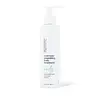What's inside
What's inside
 Key Ingredients
Key Ingredients

 Benefits
Benefits

 Concerns
Concerns

 Ingredients Side-by-side
Ingredients Side-by-side

Water
Skin ConditioningGlycolic Acid
BufferingNiacinamide
SmoothingC12-15 Alkyl Benzoate
AntimicrobialAmmonium Hydroxide
BufferingCetearyl Alcohol
EmollientButylene Glycol
HumectantKojic Acid
AntioxidantNeopentyl Glycol Diheptanoate
EmollientGlyceryl Stearate
EmollientPEG-100 Stearate
Polyacrylamide
Isododecane
EmollientSqualane
EmollientAlpha-Arbutin
AntioxidantAzelaic Acid
BufferingC13-14 Isoparaffin
EmollientCamellia Sinensis Leaf Extract
AntimicrobialCetearyl Glucoside
EmulsifyingDimethicone
EmollientDisodium EDTA
Ethylhexylglycerin
Skin ConditioningGlutathione
Lactic Acid
BufferingLaureth-7
EmulsifyingPentaerythrityl Tetra-Di-T-Butyl Hydroxyhydrocinnamate
AntioxidantPhenoxyethanol
PreservativePropyl Gallate
AntioxidantRetinyl Palmitate
Skin ConditioningTocopheryl Acetate
AntioxidantXanthan Gum
EmulsifyingWater, Glycolic Acid, Niacinamide, C12-15 Alkyl Benzoate, Ammonium Hydroxide, Cetearyl Alcohol, Butylene Glycol, Kojic Acid, Neopentyl Glycol Diheptanoate, Glyceryl Stearate, PEG-100 Stearate, Polyacrylamide, Isododecane, Squalane, Alpha-Arbutin, Azelaic Acid, C13-14 Isoparaffin, Camellia Sinensis Leaf Extract, Cetearyl Glucoside, Dimethicone, Disodium EDTA, Ethylhexylglycerin, Glutathione, Lactic Acid, Laureth-7, Pentaerythrityl Tetra-Di-T-Butyl Hydroxyhydrocinnamate, Phenoxyethanol, Propyl Gallate, Retinyl Palmitate, Tocopheryl Acetate, Xanthan Gum
Water
Skin ConditioningIsopentyldiol
HumectantLactic Acid
BufferingButyrospermum Parkii Butter
Skin ConditioningC13-15 Alkane
SolventGlycerin
HumectantPropanediol
SolventPotassium Hydroxide
BufferingIsoamyl Laurate
EmollientSalicylic Acid
Masking1,2-Hexanediol
Skin ConditioningArachidyl Alcohol
EmollientSodium Acrylates Copolymer
Honey Extract
HumectantPropolis Extract
Skin ConditioningRoyal Jelly Extract
Skin ConditioningTocopherol
AntioxidantBisabolol
MaskingOpuntia Ficus-Indica Stem Extract
Skin ConditioningCurcuma Longa Root Extract
MaskingLauroyl Lysine
Skin ConditioningArachidyl Glucoside
EmulsifyingCellulose Gum
Emulsion StabilisingLecithin
EmollientBis-Diglyceryl Polyacyladipate-1
EmollientAroma
Ormenis Multicaulis Oil
MaskingSodium Polyacryloyldimethyl Taurate
Emulsion StabilisingSodium Stearoyl Glutamate
CleansingInulin
Skin ConditioningMelia Azadirachta Leaf Extract
Skin ConditioningMelia Azadirachta Flower Extract
Skin ConditioningBehenyl Alcohol
EmollientCellulose
AbsorbentFructose
HumectantGlucose
HumectantCorallina Officinalis Extract
Skin ConditioningOcimum Basilicum Flower/Leaf Extract
TonicOcimum Sanctum Leaf Extract
Skin ConditioningCetearyl Alcohol
EmollientXanthan Gum
EmulsifyingMaltodextrin
AbsorbentLimonene
PerfumingWater, Isopentyldiol, Lactic Acid, Butyrospermum Parkii Butter, C13-15 Alkane, Glycerin, Propanediol, Potassium Hydroxide, Isoamyl Laurate, Salicylic Acid, 1,2-Hexanediol, Arachidyl Alcohol, Sodium Acrylates Copolymer, Honey Extract, Propolis Extract, Royal Jelly Extract, Tocopherol, Bisabolol, Opuntia Ficus-Indica Stem Extract, Curcuma Longa Root Extract, Lauroyl Lysine, Arachidyl Glucoside, Cellulose Gum, Lecithin, Bis-Diglyceryl Polyacyladipate-1, Aroma, Ormenis Multicaulis Oil, Sodium Polyacryloyldimethyl Taurate, Sodium Stearoyl Glutamate, Inulin, Melia Azadirachta Leaf Extract, Melia Azadirachta Flower Extract, Behenyl Alcohol, Cellulose, Fructose, Glucose, Corallina Officinalis Extract, Ocimum Basilicum Flower/Leaf Extract, Ocimum Sanctum Leaf Extract, Cetearyl Alcohol, Xanthan Gum, Maltodextrin, Limonene
Ingredients Explained
These ingredients are found in both products.
Ingredients higher up in an ingredient list are typically present in a larger amount.
Cetearyl alcohol is a mixture of two fatty alcohols: cetyl alcohol and stearyl alcohol. It is mainly used as an emulsifier. Emulsifiers help prevent the separation of oils and products. Due to its composition, it can also be used to thicken a product or help create foam.
Cetearyl alcohol is an emollient. Emollients help soothe and hydrate the skin by trapping moisture.
Studies show Cetearyl alcohol is non-toxic and non-irritating. The FDA allows products labeled "alcohol-free" to have fatty alcohols.
This ingredient is usually derived from plant oils such as palm, vegetable, or coconut oils. There is debate on whether this ingredient will cause acne.
Due to the fatty acid base, this ingredient may not be Malassezia folliculitis safe.
Learn more about Cetearyl AlcoholLactic Acid is another well-loved alpha hydroxy acid (AHA). It is gentler than glycolic acid but still highly effective.
Its main role is to exfoliate the surface of the skin by loosening the “glue” that holds dead skin cells together. Shedding those old cells leads to smoother, softer, and more even-toned skin.
Because lactic acid molecules are larger than glycolic acid, they don’t penetrate as deeply. This means they’re less likely to sting or irritate, making it a great choice for beginners or those with sensitive skin.
Like glycolic acid, it can:
Lactic acid also acts as a humectant (like hyaluronic acid). It can draw water into the skin to improve hydration and also plays a role in the skin's natural moisturizing factor (NMF) in the form of sodium lactate.
Studies show it can boost ceramide production to strengthen the skin barrier and even help balance the skin’s microbiome.
To get results, choose products with a pH between 3-4.
Lower strengths (5-12%) focus on surface exfoliation; higher strengths (12% and up) can reach deeper in the dermis (deeper, supportive layer) to improve skin texture and firmness over time.
Though it was originally derived from milk, most modern lactic acid used in skincare is vegan. It is made through non-dairy fermentation to create a bio-identical and stable form suitable for all formulations.
When lactic acid shows up near the end of an ingredient list, it usually means the brand added just a tiny amount to adjust the product’s pH.
Legend has it that Cleopatra used to bathe in sour milk to help reduce wrinkles.
Lactic acid is truly a gentle multitasker: it exfoliates, hydrates, strengthens, and brightens. It's a great ingredient for giving your skin a smooth, glowing, and healthy look without the harshness of stronger acids.
Read more about some other popular AHA's here:
Learn more about Lactic AcidWater. It's the most common cosmetic ingredient of all. You'll usually see it at the top of ingredient lists, meaning that it makes up the largest part of the product.
So why is it so popular? Water most often acts as a solvent - this means that it helps dissolve other ingredients into the formulation.
You'll also recognize water as that liquid we all need to stay alive. If you see this, drink a glass of water. Stay hydrated!
Learn more about WaterXanthan gum is used as a stabilizer and thickener within cosmetic products. It helps give products a sticky, thick feeling - preventing them from being too runny.
On the technical side of things, xanthan gum is a polysaccharide - a combination consisting of multiple sugar molecules bonded together.
Xanthan gum is a pretty common and great ingredient. It is a natural, non-toxic, non-irritating ingredient that is also commonly used in food products.
Learn more about Xanthan Gum